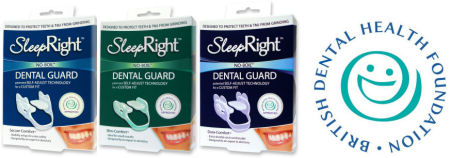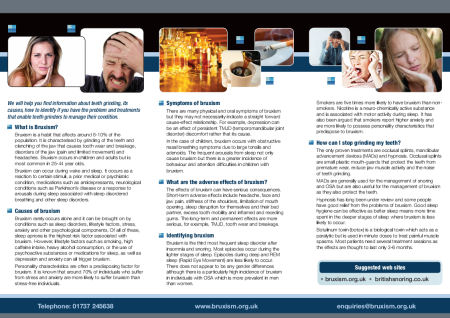Bruxism is the third most frequent sleep disorder after insomnia and snoring. Most episodes of bruxism occur during sleep stages 1 & 2 (approximately 30% & 56% respectively), whilst episodes during stages 3, 4 & Rapid Eye Movement (REM) sleep are much less likely (approximately 6%,1% & 7% respectively). Episodes that occur during REM sleep are more frequently associated with facial and dental pain.
There is a particularly high incidence of bruxism in individuals with Obstructive Sleep Apnoea (OSA) and it is thought that the episodes of bruxism occur during the arousal phase of OSA.
Stress levels and personality characteristics are often considered to be predisposing factors for several diseases and it is well documented that individuals with a highly stressful life and those with anxiety have a three times higher prevalence of sleep bruxism as compared with low stress or non-anxiety individuals.
It is not really known whether there are any gender differences associated with bruxism as different studies have found greater associations in men, others in women and some studies have found no differences at all. However, it does appear that high depressive symptoms are significantly associated with bruxism in men but it has been suggested that men may be exposed to greater job stress than women which may lead to the greater incidence of bruxism. There is a question as to whether it is the stress that initiates bruxism or whether it is a coping strategy to the stressful demands.
Conversely, bruxism associated with difficulty initiating sleep, disrupted sleep and early morning awakenings appears to be a more significant factor for women than men. This may imply a stressful work or life environment however it may be that women with subjective distress may be more likely to perceive, over-react to and complain about their sensations more than men.
What is known is that depressive symptoms are associated with poor mental health and also poor oral health status.
One study reported bruxism to be more prevalent in men than women. But, it was found that smoking was more than two and a half times greater in men than women. Without doubt, smoking is a significant factor associated with bruxism for both men and women. It is estimated that smokers are five times more likely to have bruxism and grinding episodes than non-smokers. Nicotine is a neuro-chemically active substance and is associated with motor activity during sleep. To complicate the picture, it has been argued that smokers report higher anxiety and are more likely to possess personality characteristics that predispose to tooth grinding.
Would you like to receive our most current information and offers by e-mail? Enter your e-mail address here to sign up.

The SleepRight dental guards are the only occlusal splints approved by the British Dental Health Foundation. Find out more.

If you would like us to provide your surgery with our information leaflets, please complete the on-line request form.
Do you need more information for your article or you want to organise an interview? Contact our media desk.

Introducing the world's leading oral appliance for bruxism, snoring and sleep apnoea. Read more.